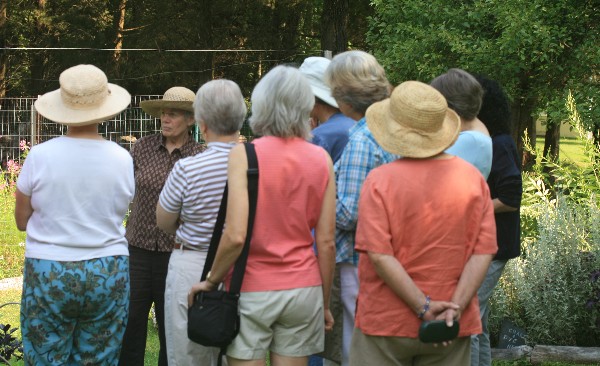
Today the Tohickon Garden Club had its meeting at The Tinicum Herb Barn at 456 Headquarters Road, in Erwinna. Pennsylvania for a program on Herbs in the Kitchen. It was terrific. First herbmistress Betsy Jacobs gave us a tour and discussion of herbs growing in the garden, explaining how she grows the wide variety of perennial, tender perennial, and annual herbs.

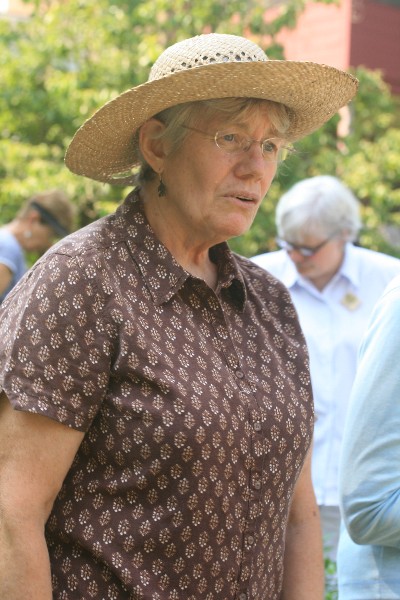
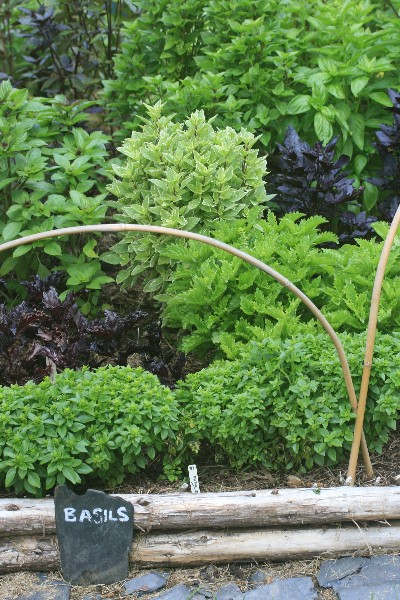
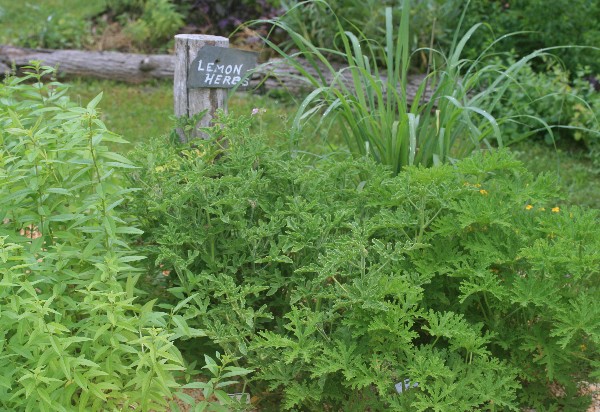
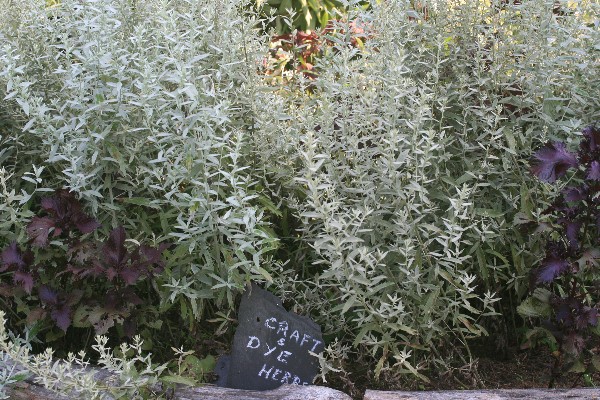
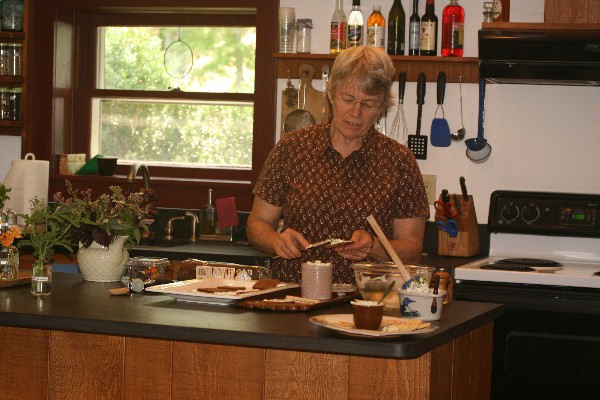
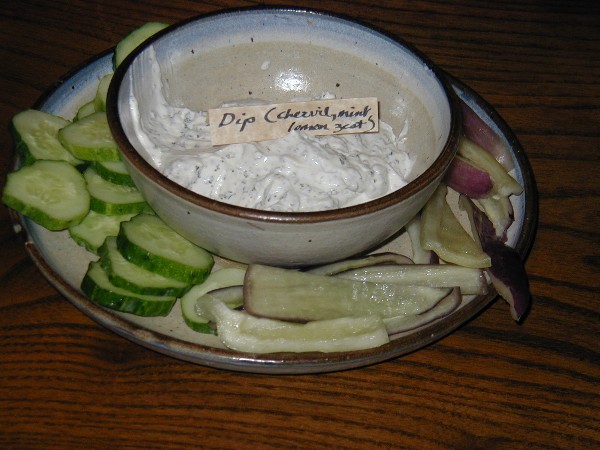
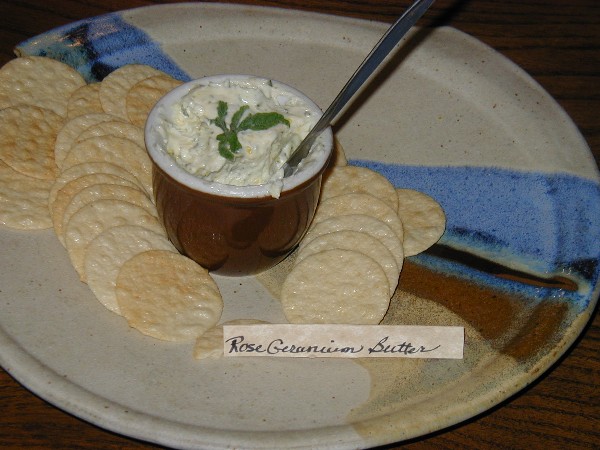



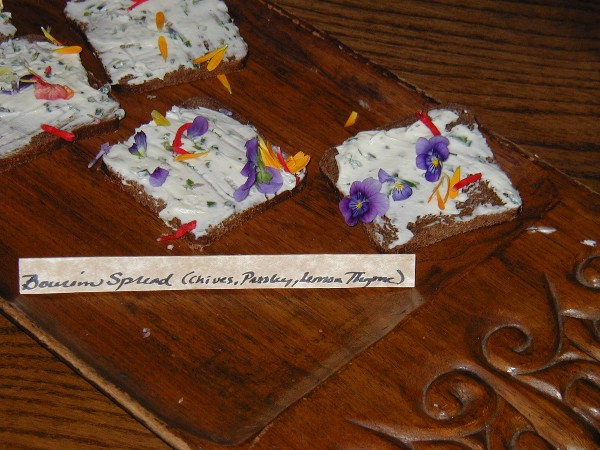
There will be an Open House at the Tinicum Herb Barn this Saturday, July 28, 2007 from 1:00 - 4:00 PM. For more information, telephone 610-847-8452, or e-mail Betsy at Tinicum Herb Barn for more information about this and other up-coming events.
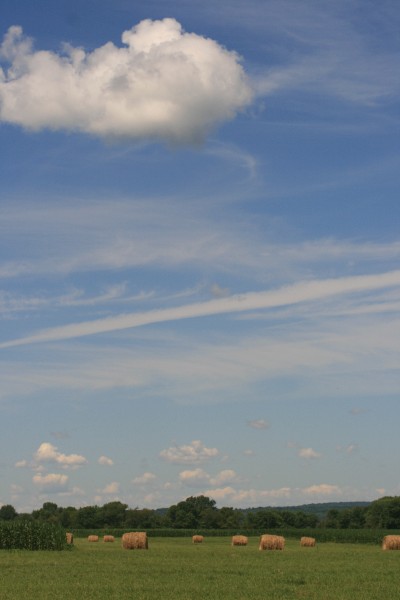
I don't have a vegetable garden. Our property is too shady. So I cultivate friends with vegetable gardens (it's never a problem with zucchini. If you grow it, you have extra.) There is the Sunday farmers market at Dvoor Farm. And in addition, there are some PYO - pick your own farms in the area. Today I went to Solebury Orchards in Bucks County, Pennsylvania. I was hoping to buy apricots. They have a few trees. But earlier this year this year an untimely frost damaged flowers when the trees were in bloom, and the harvest season for this delectable crop is a scant two weeks. So off I went, across the river and through the woods (on a road, Route 32 to be exact) on an apricot quest.
I needed more lavender. Hard to believe, considering the armful I brought home just over a week ago. But I've been busy: lavender-infused honey, peach lavender butter, lavender dried for sleep pillows, and ribbon-woven into lavender wands. So back I went today, to
Carousel Farm Lavender in Pennsylvania. (I want to make blueberry lavender jam and, if I can find succulent ones, apricot lavender jam. And some more lavender wands.)
All the espaliers at Carousel Farm are, I'm glad to say, well trained and in good shape. The next best thing to garden parties are garden tours. Not really sure which comes out on top. (It probably depends on which event is currently occurring, and how hungry you happen to be.) Today is the go-on-your-own tour of three private gardens arranged for its members by the Watnong chapter of the North American Rock Garden Society. As you might expect, since the chapter is in New Jersey, so are the gardens, in Chatham, Madison, and Morristown. A pleasant sunny day, comfortable temperatures and slight breezes. But . . . the dappled light conditions in the woodland portions of the gardens are difficult to photograph, with hot-spot burn-out against the shade. The human eye is still more adaptable than a camera's optics.
All three (plus one) are urban / suburban gardens, more modest in scale than the suburban / rural in my area. Houses readily visible across the street and side to side, with mature trees shading the neighborhoods. The open hours for the tour are 10:00 a.m. to 1:00 p.m. Since the gardens are a scant 10 minutes apart, this allows adequate time to visit. One nice touch: each garden had a chapter host on site. Their cell phone number was provided with the travel directions, in case one went astray. I decided to go furthest out first, and work my way back towards Route 287.
Conifers and flowing low walls of slate. The rear of the property elegantly delineated by a tall open fretwork wall that defines the space without blocking the view. Its posts become columns of clematis.
There is, perhaps. the remains of a building. Portions of a foundation, an opening that might have been a doorway. Within, the ground is somewhat recessed below the grade of the soil outside. There are several scattered groups of European ginger, Asarum europaeum, with glossy forest green leaves. In the rectangle is a waist-high stone column, minimally irregular in form. Its polished top ejaculates a water spout, not very high, white with air. The water descends the column and disappears into a puddle of fist-size cobbles.
We were told we could also visit the garden next door. Friends, it seems that the two neighbors had turned their properties adjoining boundary into a garden. Just go out to the street, walk past the house, and up the driveway to enter the garden though the moon gate.
.
.
Into my car and on to the next garden, in Madison. The pumpkin-colored house sits on a sloping lot. There's all sorts of pleasant vignettes worked into the landscape: a terrace behind the house, off to the side and in the shade another little terrace up a short flight of several rustic stone steps with woolly thyme, Thymus lanuginosus, carpeting portions of the supporting wall and spilling onto the steps.
.
This garden is the largest of those on the tour. The property, and that of its neighbors, were once all part of a larger estate now broken into several parcels. The one we visit is at the rear of the original piece, so while there's almost no backyard there is a generous front yard. Lawn gently sloping down towards the house, with a boundary-marking bed of shrubs and hosta. There is an island bed or two, a stone bench on the forecourt terrace, a recently renovated pool with water lilies, fish, and frogs (apparently quite popular with the neighborhood coyotes who come for a drink, and great blue herons who'd rather dine.). There's a birdbath on a handkerchief-sized terrace carved into the perennial border, with a single cafe parlor chair.
A pleasant outing. Always nice to see what others have done with their property and plants in the never-ending quest to make a garden. It is, after all, not plagiarism to bring concepts home from such a garden tour. Please, to call it research.
He's not a mutant or a ninja. He's an eastern box turtle, Terrapene carolina carolina, one of the two land turtles found in New Jersey. (The other is the wood tortoise, Glyptemys insculpta). I know he's a boy because he has such vivid orange eyes. His age is an assumption, but he is smaller than an adult box turtle, and larger than a baby.
When hatched, a box tortoise is about an inch and a half long. A number of years ago I found a two inch baby here at Bellewood Gardens. That's extremely rare, as the little ones are very shy and secretive. Is this the same one? I have no way of knowing. If it is, that's delightful. But very few box turtles survive to adulthood. Cars are the biggest predator, lethal when a slow-going tortoise tries to cross a road. Should it be a different one, that's still delightful. It means there's a breeding population in the area. Destruction of habitat through development and road building fragments their territory and isolates individuals.
So this little fellow is welcome indeed. Let him eat slugs and worms, and grow into a more herbivorian adult. Stay away from roads and traffic. (If I see one on the road I stop, and assist them in safely crossing.) Here's hoping he - and others - spend the next 30, 40, or more years of their lives roaming these woods in summer and hibernating underground in winter. Have romantic assignations and lay eggs that will hatch into other secretive little tortoises in the undergrowth. And occasionally delight me with an appearance.
This part of the gently rolling countryside in Bucks County, Pennsylvania has had several incarnations since its founding as a farm in 1748. When the current owner moved to the property seven years ago it was not to raise a dairy herd (though they have some Scottish highland cattle), nor - though they have several horses - to have it as the horse farm that it once was.Clearly, history has left an imprint on the property: in the mid-20th century it was an exotic animal farm and today as well as the already mentioned cows and horses there are goats and donkeys, llamas and chickens.
In Niko's own words, "The inspiration for Carousel Farm Lavender came when we were traveling through the beautiful Provence countryside, where the rolling hills are graced with old grape vines and lavender fields, against a stunning backdrop of centuries-old fieldstone barns and farmhouses. Our farm, with its fieldstone farmhouse, 18th century stone barn and rolling fields broken only by fieldstone walls, seemed the perfect place to replicate the South of France."
And what do they do with all this lavender? They sell it, both from their on-line store and as wholesale vendor to up-market shops. They offer bunches of fresh or dried lavender and lavender sachet, and a range of products from lotions, cream, and lip balm, liquid soap and bars of soap, essential oils and lavender water.
This is practically a life-long interest of his, beginning when he was a little boy in France and would help his uncle tend the bee hives. Today he has hives at home and also placed at farms here and there around New Jersey. Farmers like bees, busy pollinators for many crops from vegetables to fruit trees. So useful are honey bees (immigrants to our shores who arrived with European settles, along with flowers such as clover, Queen Anne's lace, ox-eye daisies, and chickory) that there's annual migrations, stoppered-up bee hives trucked from the citrus groves of Florida to California's almond orchards. Jean-Claude's bees are homebodies.
His bees make wonderful, prize-winning honey, only strained and not filtered, and raw, not heated.
But all is not well in the world of bee keepers. This spring I read a blog where a cottage smallholder in the UK posted about empty hives when they were opened at winter's end. News reports here in the United States mention the same thing on a larger scale. Jean-Claude lost the bees in about 90% of his hives. One hundred forty one hives out of 171 were wiped out. Not filled with dead bees as might be expected, or empty of honey, just empty of bees except for the queen and immature bees. Call it Colony Collapse Disorder.
There are all sorts of theories out there, from deleterious effects of cell phone towers to shifts in the earth's magnetic poles, some new disease, or . . . maybe it is due to pesticides.
It has always been important that when insecticides are used the timing must avoid when plants are in flower lest honey bees, a non-target species, also be killed. In the mid-1990s in France, imidacloprid, a popular systemic insecticide, was implicated in a catastrophic honeybee die-off. Between 1995 and 2002 honey production was cut in half. Since 2003 some uses of imidacloprid have been banned in France. It is, however, still permitted here. Manufactured by the German company Bayer CropScience, imidacloprid blocks a pathway in insect brains, leading to paralysis and death. In a 2001 article in the Journal of Pesticide Reform, German scientist Eric Zeisstoff wrote that his research "indicated that bees affected by imidacloprid suffer problems with orientation. Bees with a particular level of imidacloprid contamination at 500 meters from the colony did not return to the hive at all." Effectively, at sublethal doses imidacloprid is toxic to honeybees. Disoriented, they cannot find their way back home.
And it is critical that bees not become lost. There's something magical that happens in the intricate routine of bee and hive and flower and honey. For honey bees dance. They dance to tell other worker bees back at the hive where to find flowers with nectar and pollen. With their dance they can communicate direction and distance. Forty years ago, in 1967, Karl von Frisch and his colleagues detailed this in a book, The Dance Language and Orientation of Bees. So even if they are not killed, if the 20,000 to 30,000 worker bees (twice as many at the height of summer) in a hive go astray, become lost, so too is the hive. Colony collapse disorder.
Jean-Claude has lovely honey. I bough a 5-pound jar. His table was well stocked with honey and beeswax products. May it continue to be so.

It's clear that this is a popular place. Some are here solo, like myself. Women with toddlers, women with young children.
An older couple, from New York City. Cannot believe they came for the day, must be weekend tourists enjoying the farm.
An opportunity for a pleasant day in the country, picking blueberries, raspberries, blackberries.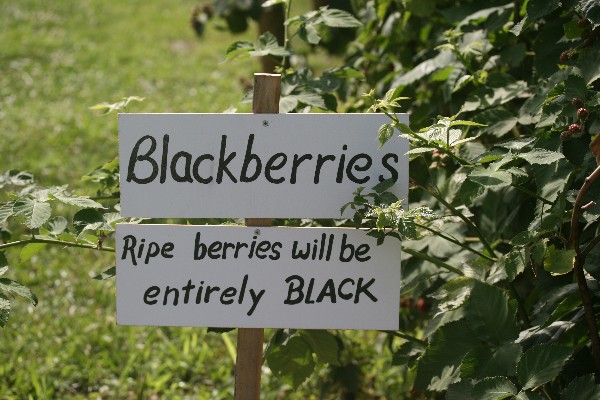

Easy picking. I got two quarts.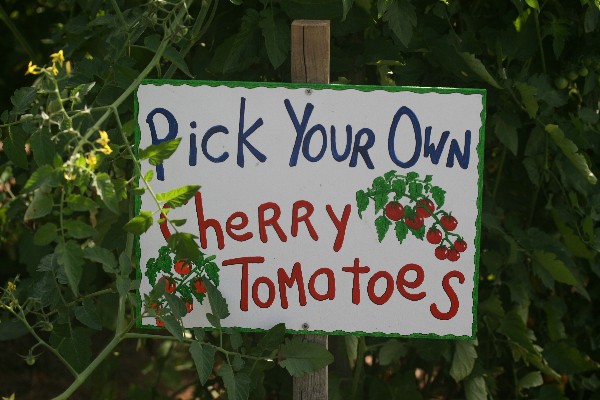
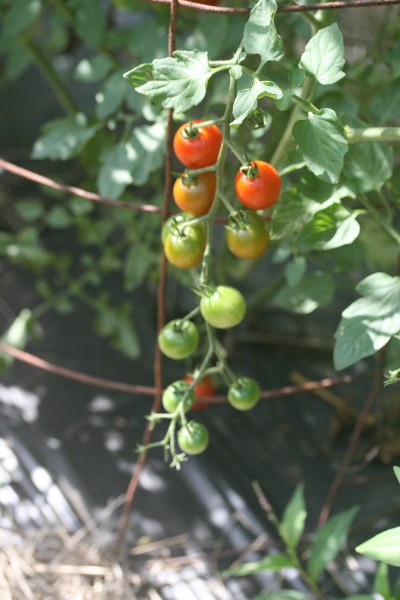
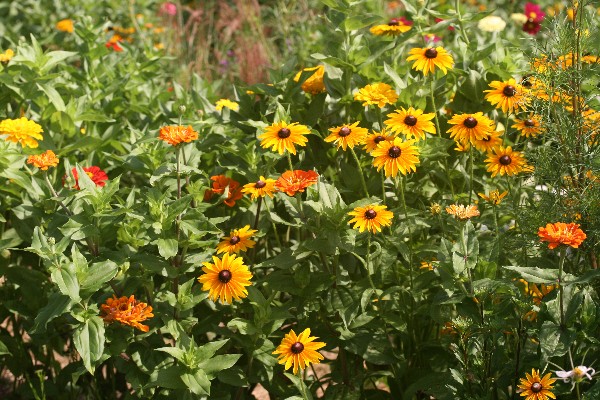
Carol generously shared oyster mushrooms she'd found. I sauteed some, then cut cherry tomatoes in half and quickly sauteed them also.
Some pan-drippings from the roast, a little water from the pasta pot, and a summer special of penne with chicken, mushrooms, and tomatoes.
Nothing other than the pasta itself was raised or found more than 15 miles from home. Doesn't get any better than this.
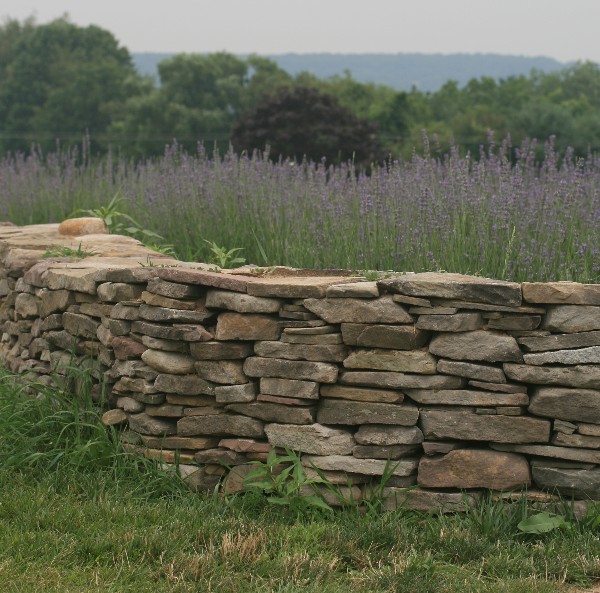
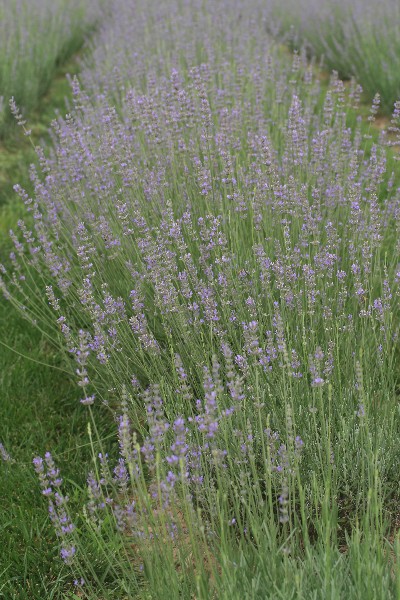
These are, I believe, the cultivar of French lavender, Provence.
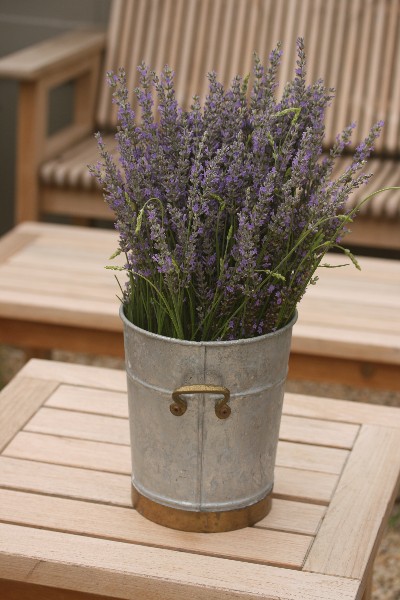
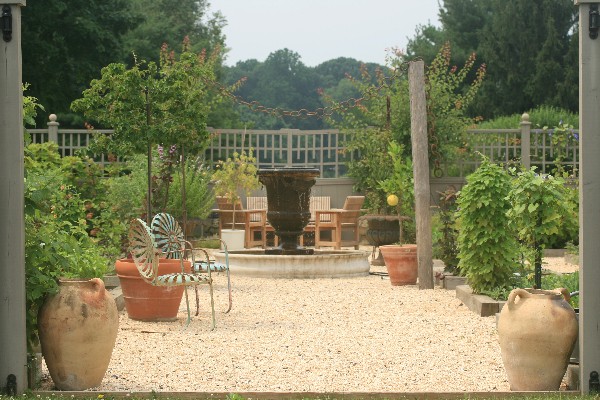
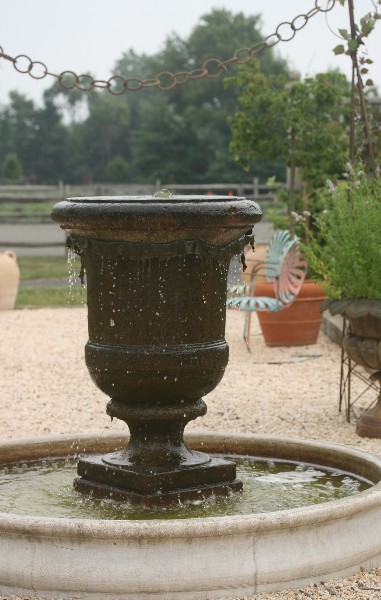

Do you recall the scene where Monsieur Hulot breaks a branch on an espalier
at the ultramodern home of his brother-in-law, while bouncing a ball with his nephew Gérard?
They trim the matching branch to disguise the damage, even it up, trim some more . . .
and tiptoe away from the denuded stick that's left.
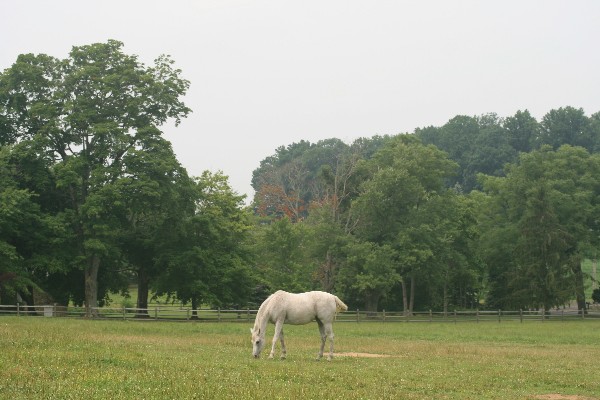
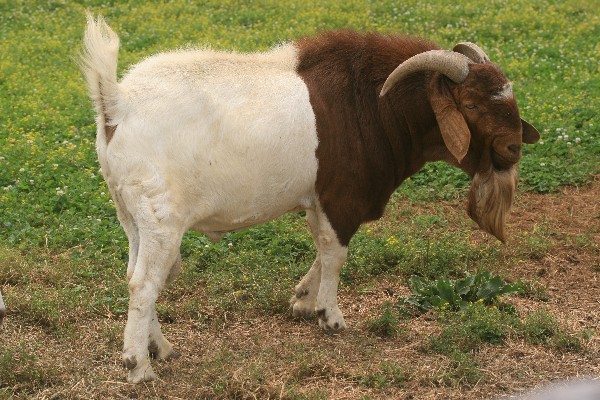

The rear of the property elegantly delineated by a tall open fretwork wall.
It defines the space without blocking the view.
Its posts become columns of clematis.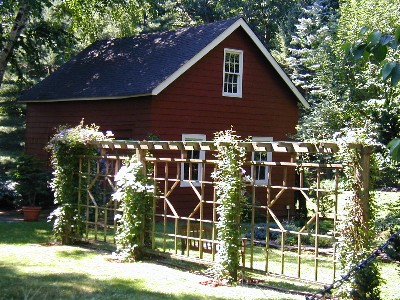
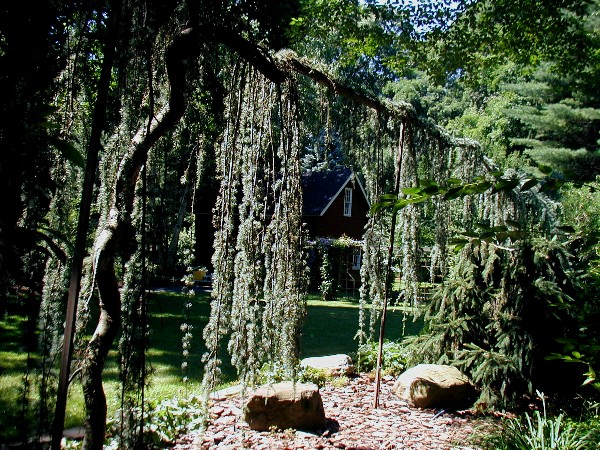
has been trained up and over.
The trailing branches create a waterfall
between two gardens, here and there.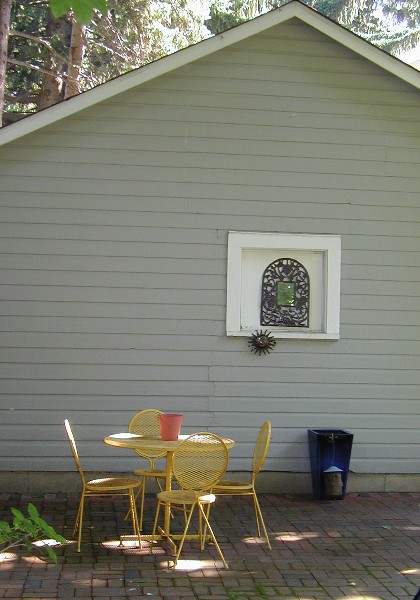
with a sunny yellow table and four chairs. Just the spot
for a glass of lemonade or iced tea on a summer's day.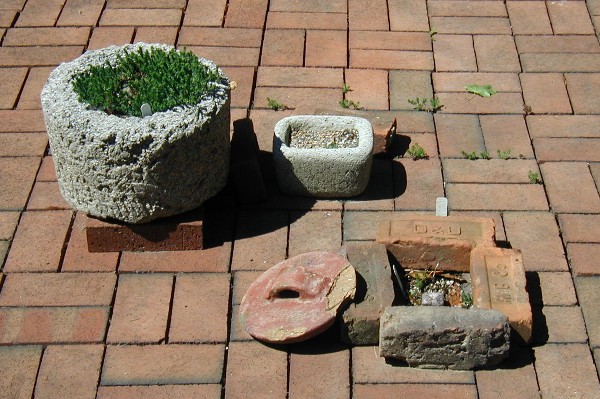
relieved with two small hypertufa planters and a brick-sized planting bed
where terrace brick was lifted out, emphasized with a border of vintage bricks.
Wonderful color pairings: a cardinal red beebalm, Monarda with
purple leaved cultivar of smoke bush, Cotinus coggygria.
of sliver-spotted Chinese wild ginger, Asarum splendens and Japanese painted fern, Athyrium niponicum 'Pictum',
with just a smidgeon of European ginger, A. europaeum, its British racing green leaves an effective foil.
Another of the shared plantings, one that - regardless of whose ground in which it actually grows -
enhances both properties.
for a tool shed. Call it a gardener's cottage. It even has curtains, an entry gate,
that leads to a raised bed herb and flower garden edged with boxwood
nicely clipped into spheres.
is a McMansion of a bird house, sturdily supported on a very ample column.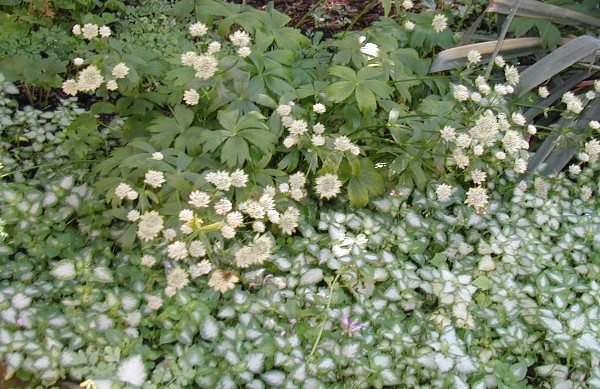
nicely covers the ground under masterwort, Astrantia major.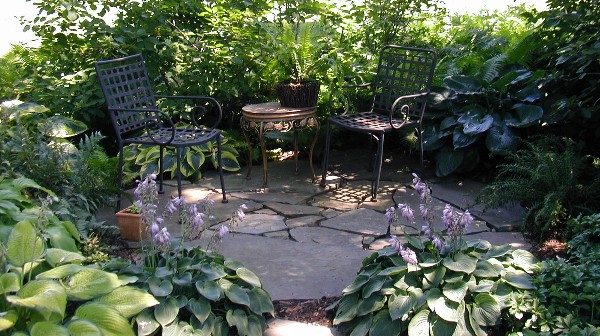
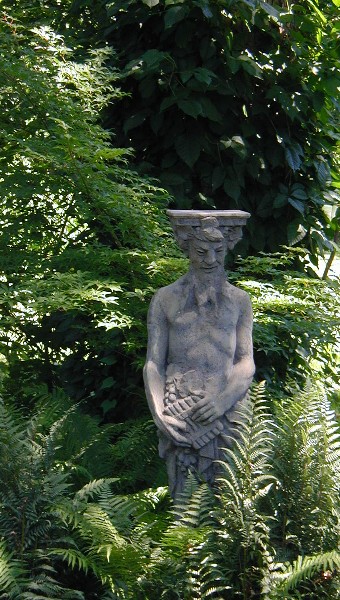
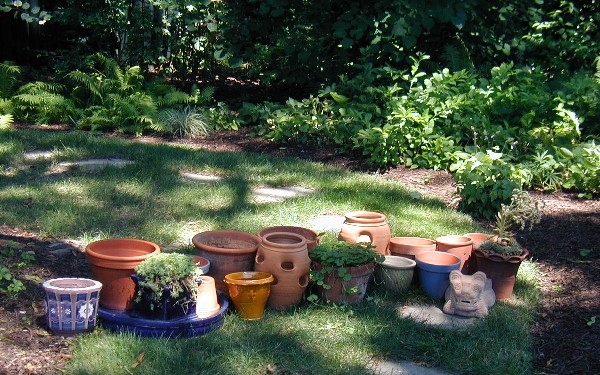
a collection of mostly empty flowerpots and a ferocious-looking terra cotta Mexican jaguar pot.
paired up with a day lily whose apricot / peachy flowers have an "eye" that nicely matches its color.
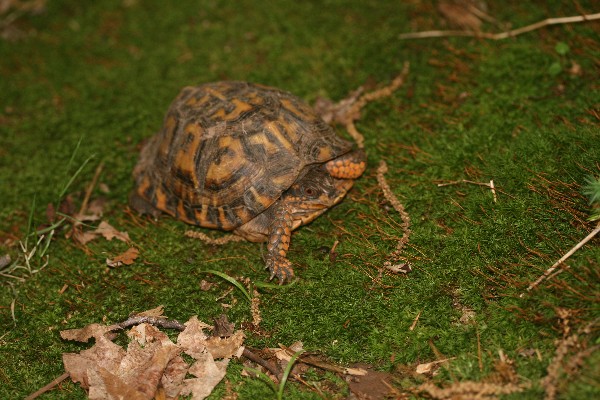

Fields of lavender were in bloom, thousands of plants.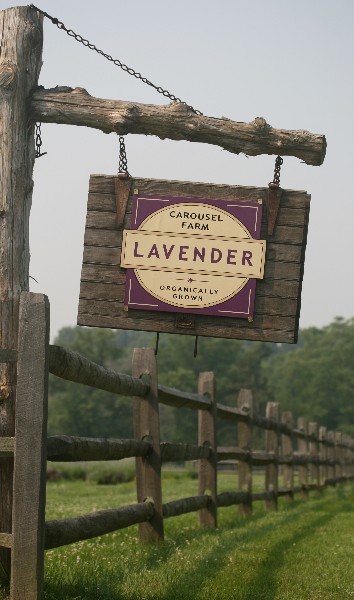
Careful analysis, site and soil testing lead to the selection of just four cultivars:
Hidcote and Munstead English lavender, and Grosso and Provence French lavender.
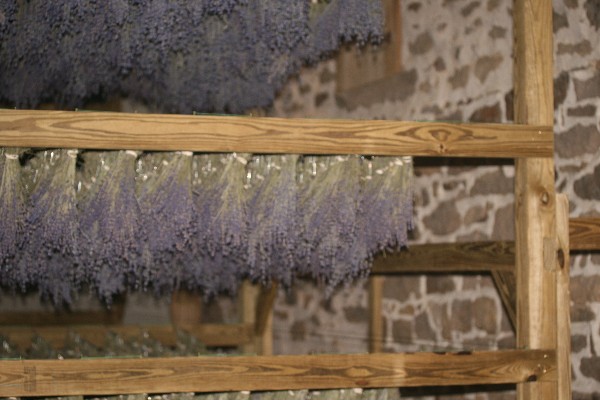
The first to be cut is English lavender. The plants will provide a second harvest at summer's end.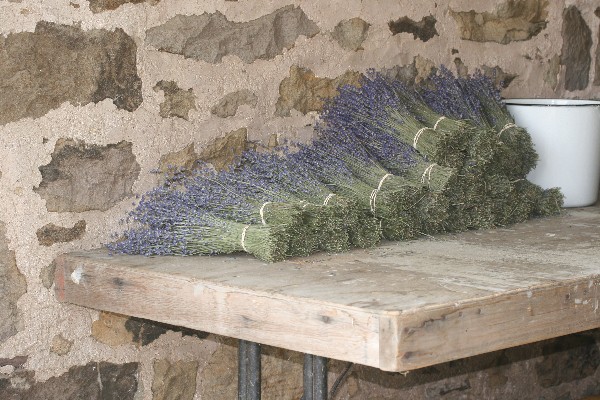
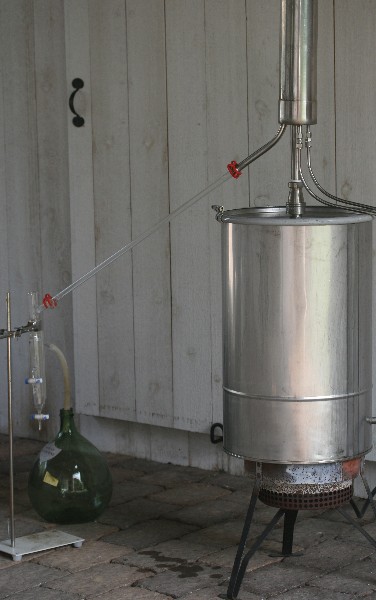
and the paddock with three friendly donkeys is there too.
Stone barns characteristic of Bucks County (and Provence), dry-laid stone walls,
a potager with raised beds filled with vegetables, espalier fruit trees, colorful foliage and flowers.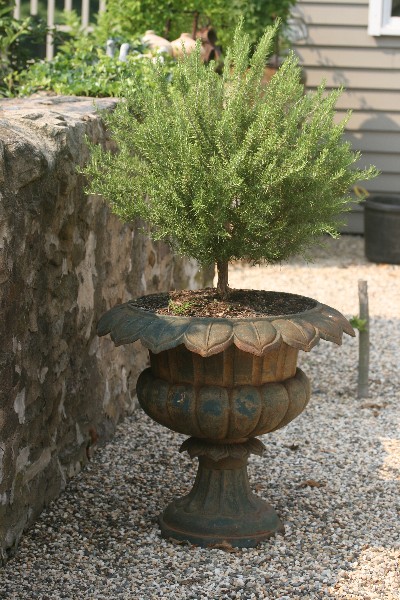
short stout trunk supporting a billow of greenery.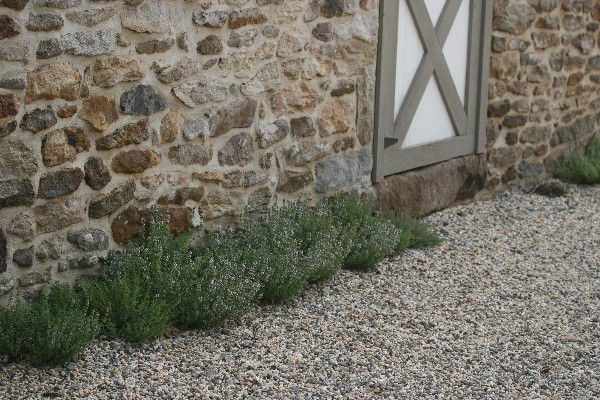
making a lace-like fichu edging.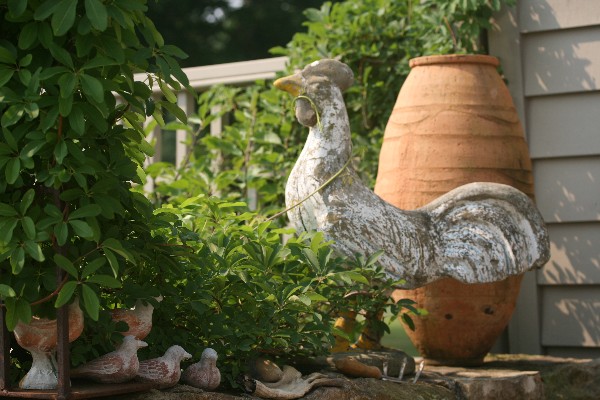
as little doves huddle in the ivy, and a gardener's glove and hand cultivator
become part of the assemblage.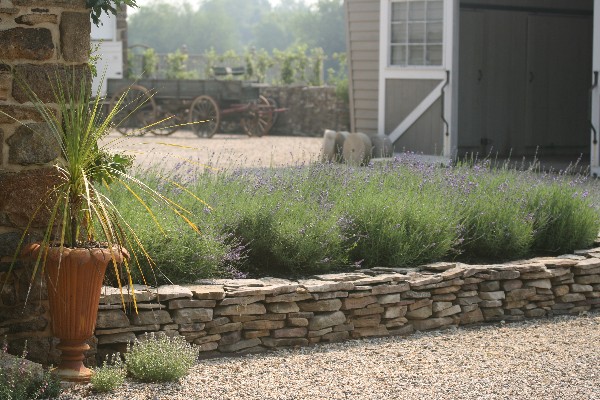
portions of the farmyard, beyond which - a clutter of millstones
(or should that be a groaning of millstones?)
and an open buckboard wagon.
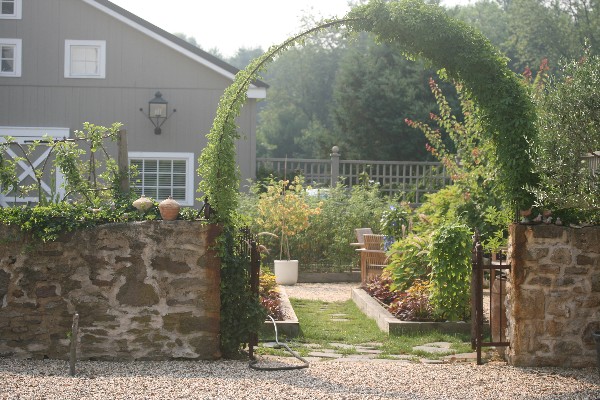
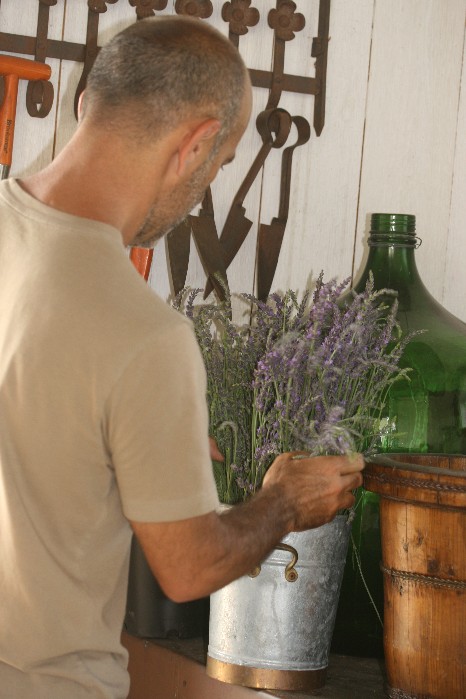
"Grosso." he told me. "That's the best for cooking." And cut a huge bunch for me. I'd brought a florist's bucket
so we could add water and keep the lavender fresh while I drove home. My car smelled so wonderful.
And the next morning, when I got into the car again, the perfume was still there, that hot
intense perfume of lavender, though hours had past since I carried them indoors.
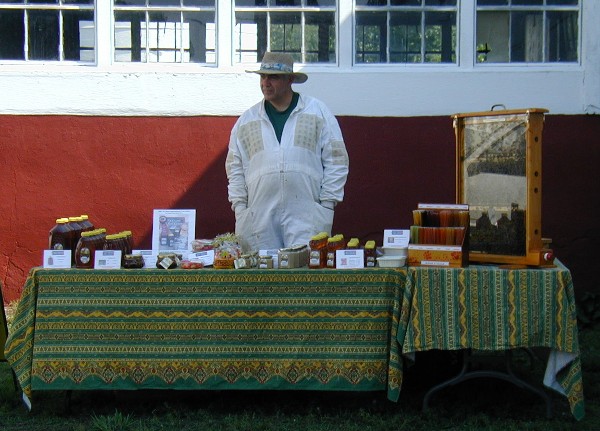
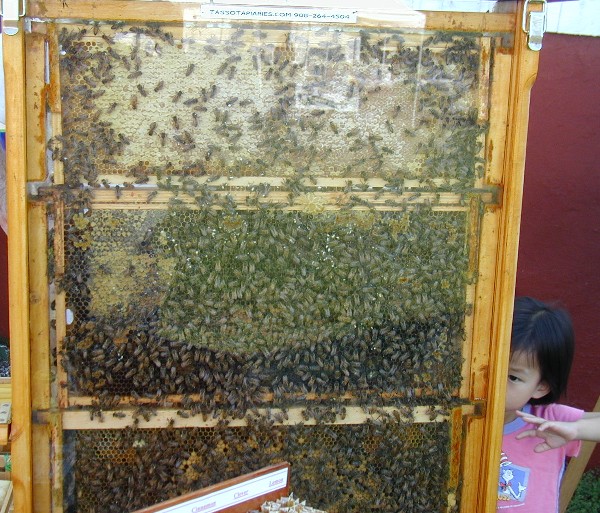
"The bushes are loaded. I have to pick 24 quarts on Monday evening,
for a woman who uses them for muffins. She's a professional baker.
There's plenty if you want some."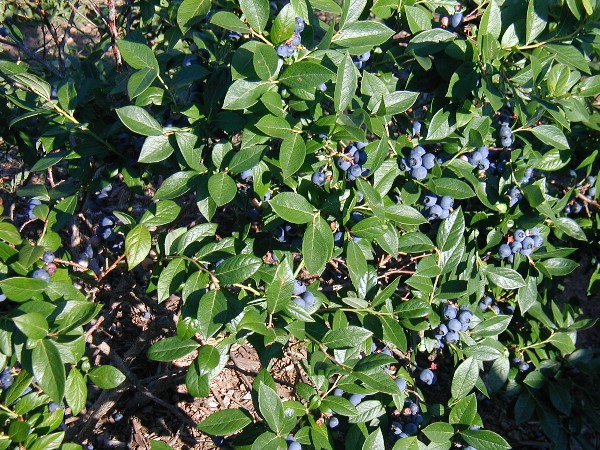
That's where the blueberry fields are. And here a row of zucchini and
there a row of potatoes. And rows of knee-high oak trees
that Dan is raising from acorns.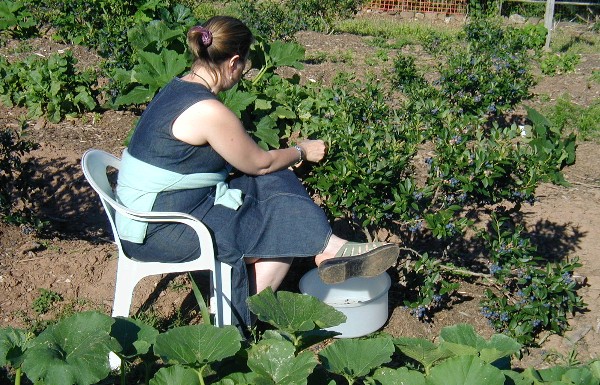
Plink, plink, into the big metal bowl. Quickly the bottom is covered
and the berries fall soundlessly. She's so coordinated today
with blueberry blue polish on her toenails.


talking, voices rising and falling, and picking berries, sharing work the way women do.
Georgeann, her mom, her daughters, me, another of her friends.
Picking memories to bring home with me, along with berries.
tasty food. But there's something that makes this one extra special. It's for Nadia,
whose grandmother is in the garden club to which I belong.
And 3 months ago she had a liver transplant.
Today's party has a modest entrance fee for a visit
to Lisa and Bill Rohrbach's pleasant garden in Perkasie, Pennsylvania.
And the proceeds will help with her medical bills.
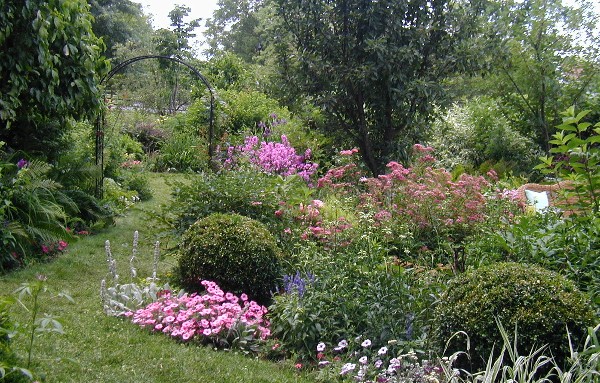
were it not for the island beds, trees, and shrubbery
that create an oasis of privacy from neighbors.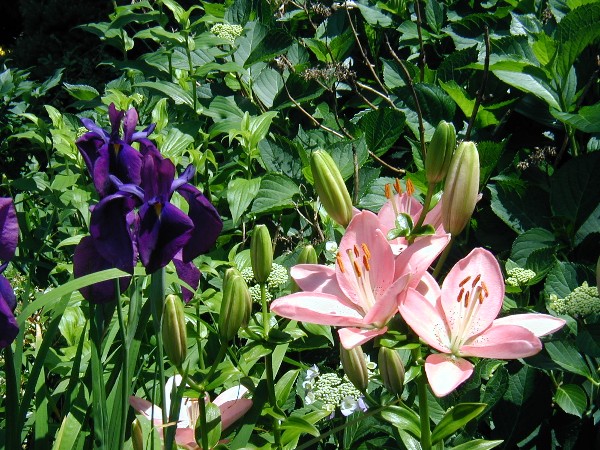
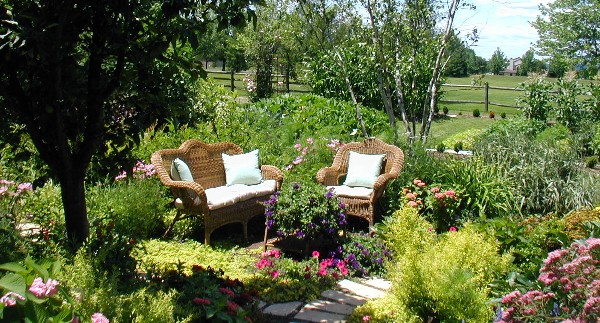
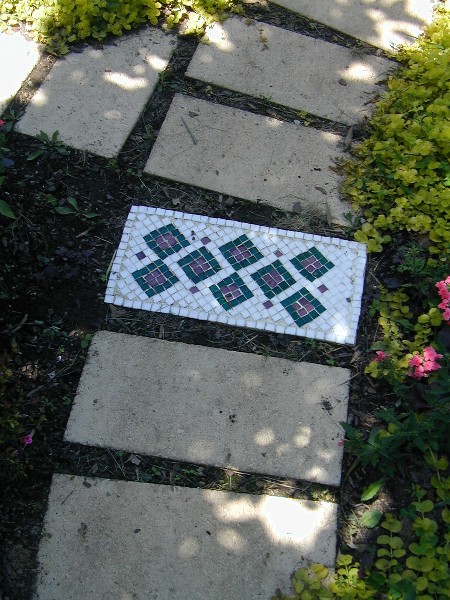
Lisa, our garden hostess, made these herself. And told me that it is easy.
Lay out your pattern, then use a dollop of caulking to fasten each tile to the paver.
While each mosaic had a unique design they all had the same colors -
forest green and wine on white, providing a nice sense of unity and harmony. 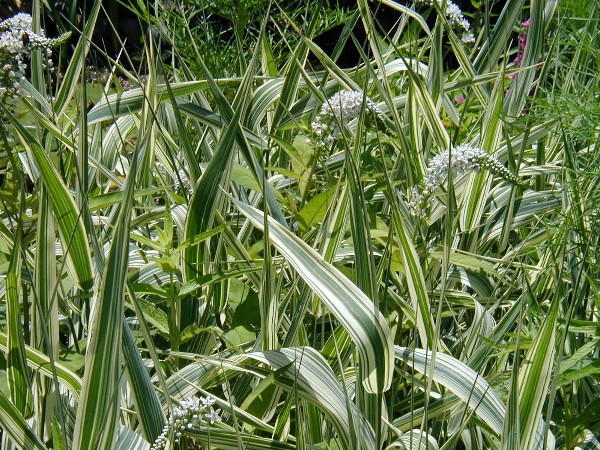
mingling with gooseneck loosestrife, Lysmachia clethroides.
Here's hoping the tangled threads of Nadia's life
smooth out and form a harmonious tapestry filled with pleasant days.